The Hammer Years
We ended part one of this examination of Frankenstein in the cinema by mentioning Milton Subotsky. At this point, it may (or may not!) be of interest to you to know that Phil Alexander’s first job after leaving school in 1969 was at Shepperton Studios. At the time, Milton Subotsky had his permanent office there and when Phil arrived two of Amicus’s films (The House that Dripped Blood and Scream and Scream Again) were in the post production stage. During the two and a half years that Phil spent at the studios, Amicus also made I, Monster, What Became of Jack and Jill? and Tales from the Crypt. Phil used to bump into Milton Subotsky practically every day and even gave him one of his early writing efforts to read, an absolutely dreadful script entitled “Revenge of the Axe”. Needless to say, the script was returned a few days later with some diplomatically kind words of encouragement, but unfortunately not accompanied by the fat cheque for which Phil had been hoping!!!
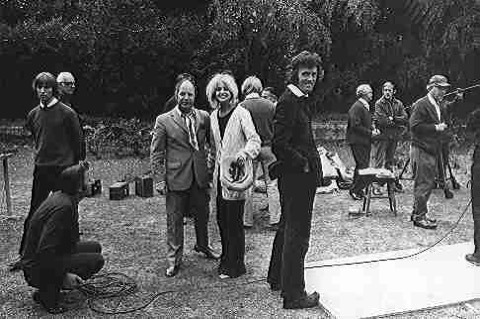
A rather young Phil Alexander can be seen on the far left of this photo, which also features Goldie Hawn. It was taken on the 3rd July 1970 at Shepperton Studios during the making of There’s a Girl in my Soup.
Hammer aficionados may be interested to know that two of their occasional production staff are also in the photo. Grinning in the foreground, with his hands in his pockets, is David Tringham, assistant director on The Witches (1966). To the right, in the cap, is Harry Waxman, director of photography on She (1965), The Nanny (1965) and The Anniversary (1967).
Anyway, enough of that – back to Frankenstein!
Part 2 – The Hammer Years
The script which Milton Subotsky took with him to Hammer in 1956 was totally unsuitable for production. Quite apart from apparently being a bit boring, according to Anthony Hinds, it was also a virtual rehash of Universal’s 1931 film and, had Hammer gone ahead with it, there seems little doubt that Universal would have issued a writ for breach of copyright. Subotsky’s project was therefore wisely dropped, but nevertheless the idea of a new treatment of Frankenstein still appealed to Hammer and Jimmy Sangster, who had recently written the screenplay for X the Unknown, was given the job of coming up with a new script. Terence Fisher was assigned the direction of the film – by a happy quirk of fate, he just happened to be owed a picture under the terms of his contract with Hammer – and with composer James Bernard, production designer Bernard Robinson and photographer Jack Asher joining the company’s usual production staff, the team behind the camera was in place.
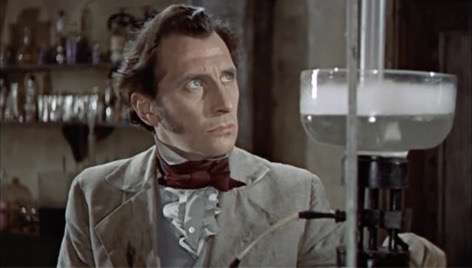
In the role of Frankenstein himself, Hammer secured the services of Peter Cushing. In the early 1950s, Cushing had become an immensely popular star of BBC TV drama productions, winning three best actor awards for his work in plays such as The Winslow Boy, Gaslight, Beau Brummell, The Spread of the Eagle and, probably most famously of all, as Winston Smith in George Orwell’s Nineteen Eighty-Four. Hammer had been keen to sign him up for some time, but it was not until 1956 that the fateful gap appeared in his television work and he was able to accept their offer. For the part of the Baron’s monstrous creation, an actor was required who was not only physically strong and tall, but who could also turn in a creditable performance without speaking a single word of dialogue. With his experience of mime in the theatre, Hammer found in Christopher Lee, a busy but not very well-known actor, exactly what they were looking for and, with the added benefit of a strong supporting cast headed by Hazel Court and Robert Urquhart, The Curse of Frankenstein went into production, giving birth to a new era of cinema horror.

Jimmy Sangster’s screenplay was in fact not so much an adaptation of Mary Shelley’s novel as a completely new story, with very little of the original remaining intact. Very briefly, in “The Curse” Baron Frankenstein sets out to create a perfect human being, but instead creates a rampaging, murderous monster which is eventually destroyed in a tank of acid. Left with no evidence that it ever existed, Frankenstein himself is sentenced to be guillotined for the crimes committed by his creation. In a way, though, the film’s plot is unimportant, because what was really remarkable about it was that it fundamentally rewrote all the previously established rules and conventions concerning the making of horror films, presenting the viewer with a no-holds-barred plethora of blood-soaked images, all in the brilliant red of Eastman colour.
Predictably, the critics were appalled and gave the film a unanimous mauling, dubbing it sadistic, revolting and an insult to the sensitivities of the cinema-going public. However, as so often happens, the cinema-going public, being an animal perfectly capable of making up its own mind, took absolutely no notice of the critics (let alone agreed with them!) and voted with its feet, forming long queues on the film’s release round the world. The sensational popularity of the film ensured that its production cost (under £70,000) was recouped many times over in next to no time at all, but more than that, it catapulted Hammer from relative B-movie obscurity into the far more lucrative limelight of main feature production; it made virtually overnight major film stars of both Peter Cushing and Christopher Lee and gave them both their long careers as joint kings of British horror; and, of course, it ushered in a whole series of Hammer Gothic horror movies.
The success of The Curse of Frankenstein prompted Hammer to make its own version of Dracula (US title Horror of Dracula; 1958) and that film’s even greater financial return secured the future of the Gothic revival. The time was already ripe for a Frankenstein sequel and in the same year The Revenge of Frankenstein”appeared. Hammer had very sensibly left the Baron alive at the end of “The Curse” and, although he is seen on his last walk to the guillotine, the film ends before the blade drops.
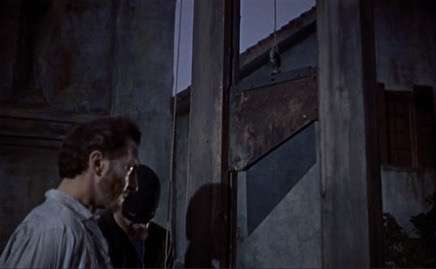
This undoubtedly made things a little easier for Jimmy Sangster, whose task it was to script the new film, and “Revenge” opens with Frankenstein being saved from losing his own head by the hapless priest officiating at the execution losing his instead! It transpires that the substitution had been arranged by the Baron bribing the executioner’s assistant, a dwarf named Karl (Oscar Quitak), with the promise to give him a new body. Frankenstein escapes with the dwarf and under a false identity sets up a medical practice in the town of Carlsbruck.
His more unorthodox work continues, however, under cover of a charity hospital for the poor, which conveniently provides him with a steady supply of amputated body parts and, now also assisted by Hans (Francis Matthews), he carries out his promise to Karl and transplants his brain into a new body. The resultant creation (played by Michael Gwynn) is at first a perfect specimen, but it is not long before things go badly pear-shaped when he is viciously beaten up by Frankenstein’s janitor (George Woodbridge). Karl’s brain is damaged in the attack and he rapidly degenerates into a wild, animal-like creature with a horrific taste for cannibalism. The injury eventually kills him, but not before he has revealed the Baron’s true identity, which causes the patients at the hospital to turn on him and beat him almost to a pulp.
Fortunately, however, Frankenstein has catered for just such an emergency and happens to have in stock a replacement body which is an exact replica of himself! Hans operates on him, repairing his brain and putting it into the new body, then, having satisfied the authorities of the Baron’s death by presenting the old body to them, he nurses him back to health. The film ends in London, where the two of them have fled and where Frankenstein has set up practice in Harley Street – clearly now very much a self-made man!
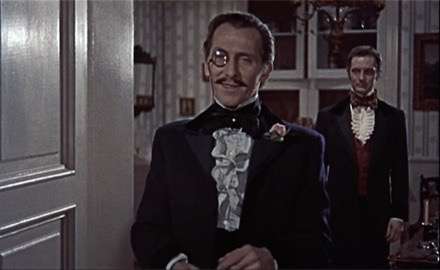
The Revenge of Frankenstein is a worthy successor to “The Curse” and it consolidated the positions of both Terence Fisher as the series’ principal director and Peter Cushing as Hammer’s Frankenstein, although all rules have exceptions and we shall cover these later. In much the same way as he took the character of Van Helsing as his own in the “Dracula” films, Cushing became virtually irreplaceable as the Baron and it was this fact that led to the major difference between the main Hammer series and the earlier Universal productions. Whereas in the old films it was the monster which remained constant throughout with the character of Frankenstein changing and eventually vanishing completely (to the extent that the name Frankenstein came to be more associated with the creation than with the scientist), in the Hammer series the ‘k factor’ was the Baron and it was his creations that changed from film to film.
Chronologically, Hammer’s next Frankenstein project (also in 1958) was a pilot for a proposed TV series entitled Tales of Frankenstein, but we shall leave that to one side for the moment while we concentrate on the cinema films starring Peter Cushing. Suffice it to say at this stage that for Hammer the experience was a nightmare probably worse than anything induced by their films and the TV series was unceremoniously abandoned!
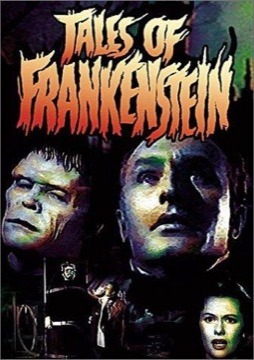
Thereafter, the Baron had a six-year rest before resurfacing in 1964 in The Evil of Frankenstein, again starring Peter Cushing but this time penned by John Elder (Anthony Hinds) and directed by Freddie Francis, temporarily replacing Terence Fisher, who was unable to take on the film owing to illness. Francis had been a camera operator (e.g. the John Huston/Humphrey Bogart film Beat the Devil, 1953) and was still a highly respected director of photography (e.g. Jack Clayton’s 1961 ghost story The Innocents, starring Deborah Kerr), as well as having also directed the psychological thriller Paranoiac for Hammer in 1963. The Evil of Frankenstein does not follow directly on from “The Revenge”, which ends with the Baron in London, but has Frankenstein returning to his home town with his new assistant Hans (Sandor Eles), where he discovers his castle ransacked and his property confiscated by the local dignitaries. With the help of a mute peasant girl (Katy Wild), he also discovers a previous creation frozen in the ice of a mountain cave. He thaws the creature out and revives it, but, in order to reactivate its brain, he has to resort to the services of Zoltan (Peter Woodthorpe), an unscrupulous fairground hypnotist.
Unfortunately, Zoltan has his own plans for the monster and, since he is now the only person it will obey, he is able to use it for his own greedy and vengeful ends. Eventually, though, the creature turns on him and kills him, but then drinks a bottle of chloroform (mistaking it for brandy) and, writhing in agony, starts a fire in the castle in which both it and Frankenstein are apparently destroyed. The film is frankly a little disappointing, despite the fact that, because it was made for Universal, Hammer had the advantage of being able to use a make-up which closely resembled that of Boris Karloff in the original 1931 production. (Incidentally, also in 1964, Universal allowed an even more faithful reproduction of the make-up for Fred Gwynne as Herman in the TV series The Munsters).
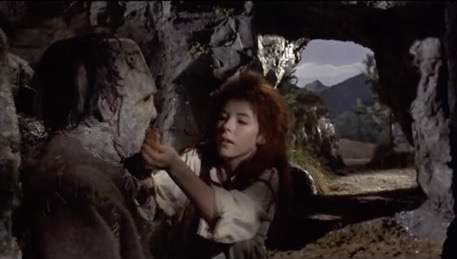
The main problem with “Evil” seems to lay with the casting of Kiwi Kingston as the monster. Kingston, a New Zealander, was by profession a wrestler rather than an actor and fails to bring any characterisation to his role, although, to be entirely fair, this criticism could be a little over the top given that the creature is meant to be under hypnotic influence for most of the film. Whatever the reason, though, “Evil” remains at the weaker end of the Cushing “Frankensteins”.
Things took a marked turn for the better two years later in 1966, when Hammer produced Frankenstein Created Woman (released in 1967), with Terence Fisher firmly back at the helm. Again scripted by John Elder (Anthony Hinds), the film has Peter Cushing dabbling with the existence of the soul and trying to isolate it from the body after death, assisted on this occasion by Doctor Hertz (a deliciously dotty performance from Thorley Walters) and young Hans (Robert Morris).
Frankenstein is presented with the perfect opportunity to test his theories when Hans is wrongly accused of murdering the landlord of the local inn, with whose crippled daughter Christina (Susan Denberg) he is having an affair. Hans is found guilty and guillotined, but his execution is witnessed by Christina, who promptly commits suicide by hurling herself into a nearby river. Frankenstein manages to get hold of both bodies, operates on Christina to cure her disabilities and then brings her back to life, having first transferred Hans’s soul into her body.
The now voluptuously beautiful, but possessed, Christina Mark II then embarks on a vengeful orgy of murder against the three thugs who were really responsible for her father’s killing and, once Hans’s revenge is complete, she destroys herself by drowning again. The film’s generally fast pace and moments of suspense and horror are nicely counterbalanced with lighter moments involving the eccentric Thorley Walters and the beautiful Austrian actress Susan Denberg acquits herself well in the role of Christina. Off screen, however, the story was very different and she descended into a downward spiral of high living, drugs and sex which caused her severe mental problems and illness, although reports of her death a few years after this film were untrue. Whatever the final outcome, her acting career was certainly tragically cut short by the pressures of fame.
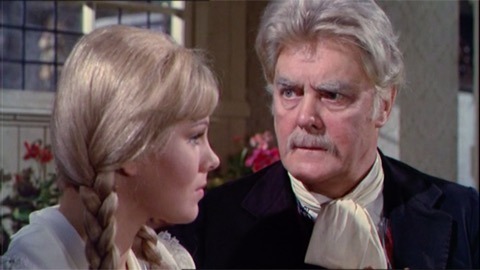
Shortly after Frankenstein Created Woman, Hammer vacated Bray Studios and the next film in the series, Frankenstein Must Be Destroyed, was made in 1969 at the Associated British Studios in Elstree, to the north of London in Hertfordshire. The more than usually complicated script was written by Bert Batt, one of Hammer’s regular assistant directors, from a story he had co-written with producer Anthony Nelson-Keys, whose last film for the company it was to be. The film has a sad footnote in that it was also the last production to be designed by Bernard Robinson, the man whose brilliantly economical and atmospheric sets had contributed so much to the success of Hammer; his death in 1970 was a severe blow to the company.
Once again directed by Terence Fisher, who was by this time in failing health, Frankenstein Must Be Destroyed starts with the Baron (Peter Cushing) yet again forced to flee and adopting a fake identity. This time, posing as a Doctor Fenner, he moves into a boarding house owned by the beautiful young Anna Spengler (Veronica Carlson), whose boyfriend Karl (Simon Ward) works at a local lunatic asylum. In order to finance her sick mother’s health care, Anna and Karl are engaged in some highly illegal business, trafficking drugs which Karl steals from work and, when Frankenstein discovers their shady secret, he seizes the opportunity to blackmail them into helping him. One of the patients at the asylum is a Doctor Brandt (George Pravda), an ex-colleague of Frankenstein’s whose brain holds the key to a problem the Baron is determined to solve. He plans to kidnap Brandt and operate on his brain to cure his insanity, thus enabling him to reveal his secret.
Frankenstein forces Karl to help him abduct Brandt, but he suffers a heart attack during the escape, necessitating the immediate transplant of his brain into a healthy body. A Professor Richter (Freddie Jones) becomes the reluctant donor of the new body and the operation goes ahead, in effect of course resulting in Frankenstein and Karl, abetted by Anna, committing murder on Richter. However, by this time Frankenstein is being pursued not only by the police (another nicely eccentric turn from Thorley Walters), but also by Brandt’s wife (Maxine Audley) who is desperately trying to find her missing husband. She gets too close for comfort, compelling Frankenstein to take to his heels again, taking with him Anna, Karl and Richter/Brandt, who is still recovering from the operation. When he does eventually come round, Anna, terrified and taken by surprise, stabs him and, badly wounded, he staggers out into the night heading for Brandt’s wife’s home.
When Frankenstein discovers what has happened, he kills Anna in his rage and rushes after his patient, pursued by the now distraught Karl. Not surprisingly, Brandt’s wife has a bit of difficulty recognising her husband when he turns up at her house, since he now has a different body and voice, but he eventually manages to convince her of the truth. Equally unsurprisingly, she is horrified and rejects him utterly, so sadly he allows her to leave. When Frankenstein arrives, Richter/Brandt traps him in the house and sets fire to it, intending to destroy not only both of them but also the papers containing the secret the Baron so badly needs. But, Frankenstein grabs the papers and makes his escape, only to be brought down by Karl and recaptured by Richter/Brandt, who carries him back into the blazing house to his (almost) certain doom.
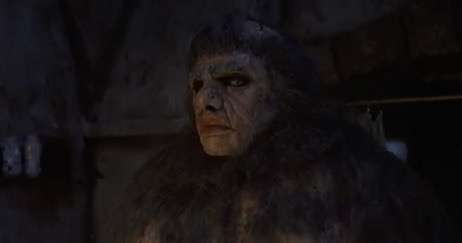
Helder immediately recognises Frankenstein, convinces him to take him on as his assistant and is eventually allowed to help the Baron in his ‘private’ work. Together they revive a dead patient, Herr Schneider (David Prowse), a grotesque (and very hairy) Neanderthal giant of a man, replacing his brain with that of a brilliant mathematician (Charles Lloyd-Pack), whom Frankenstein has incited to commit suicide. At first, all seems to be well, but of course things go wrong when the Neanderthal instincts of the body begin to take over the new brain and the Baron’s creation again embarks on a blood-spattered rampage, until it is finally torn to pieces by the lunatic inmates of the asylum. The film is not up to the usual standard, largely thanks to its small budget, and it suffered further from inadequate distribution; also, the monster itself looks so dreadful that it verges on the laughable. Hammer’s final foray into Frankenstein sadly ended up a box-office flop and the series fizzled out with a whimper rather than a bang.
Now before we finish, we must return to Hammer’s two other Frankenstein ventures.
Firstly, the TV pilot Tales of Frankenstein (1958) was an all round disaster. Filmed in black and white by Screen Gems, the television subsidiary of Columbia Pictures, it starred Anton Diffring as the Baron, but it was made in Hollywood by a crew who had no understanding of the Hammer product. Alarm bells soon began to ring back in England and Anthony Hinds was hurriedly dispatched to America to see if he could sort out the mess. Unfortunately, though, it appears that it was so bad that not even he could do anything with it and the entire project sank, virtually without trace.
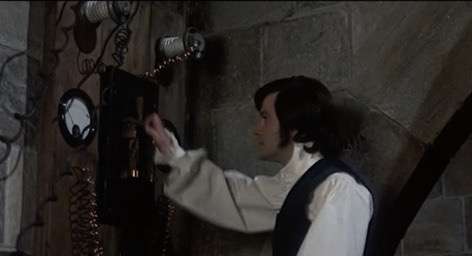
The only other time that Hammer ventured to tinker with the Baron without Peter Cushing was The Horror of Frankenstein (1970). Starring Ralph Bates in the title role and David Prowse as his creation (he later also played the creature in Frankenstein and the Monster from Hell), the film is virtually a remake of The Curse of Frankenstein, but this time done with a black sense of humour and with added sexual content. Generally it is not a good idea to have a film written, produced and directed by the same person, since obviously it reduces the amount of people who can bounce suggestions and opinions off each other. Jimmy Sangster took on all three jobs for The Horror of Frankenstein and, although he himself has stated that he found it his most enjoyable film to make, it is a pity that he could not find a way to share his pleasure with the audience. The film comes across as stale and lacking in fresh ideas and, for that matter, better jokes and more amusing situations would not have gone amiss in what was after all supposed to be a tongue-in-cheek version of the story. In any event, it was a wasted opportunity to do something a bit against the grain and the film did not do good business at the box-office.
In conclusion, “Frankenstein” has not of course been the exclusive property of Universal and Hammer and many, many other films from all over the world have exploited the story down the years. Other variations include Herman Cohen’s notorious Grade-Z drive-in movie I Was a Teenage Frankenstein (1957), Allied Artists’ Frankenstein 1970 (also 1957, starring Boris Karloff), Toho’s Japanese nonsense Frankenstein Conquers the World (1965), Canada’s Frankenstein on Campus (1969), Universal’s star-studded two part TV film Frankenstein: the True Story (1974) and Mel Brooks’ hilarious spoof Young Frankenstein (also 1974). More recently, two lavish and expensive productions have appeared with the Turner Pictures/David Wickes TV movie Frankenstein: the Real Story (1992) and Kenneth Branagh’s Mary Shelley’s Frankenstein (1994).
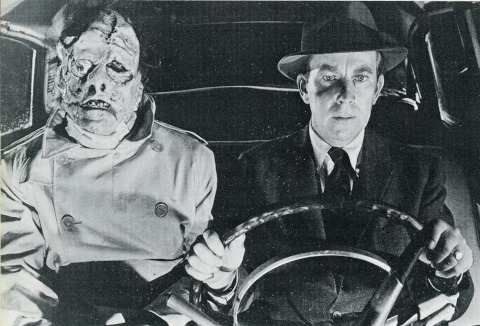
Yet, despite all the competition, it is a tribute to two great horror actors that, at the mention of the name “Frankenstein”, the images that immediately spring to most people’s minds are those of Boris Karloff as the monster and Peter Cushing as the scientist. What a shame it is that they not once made a film together!
